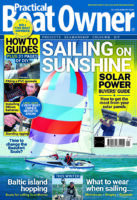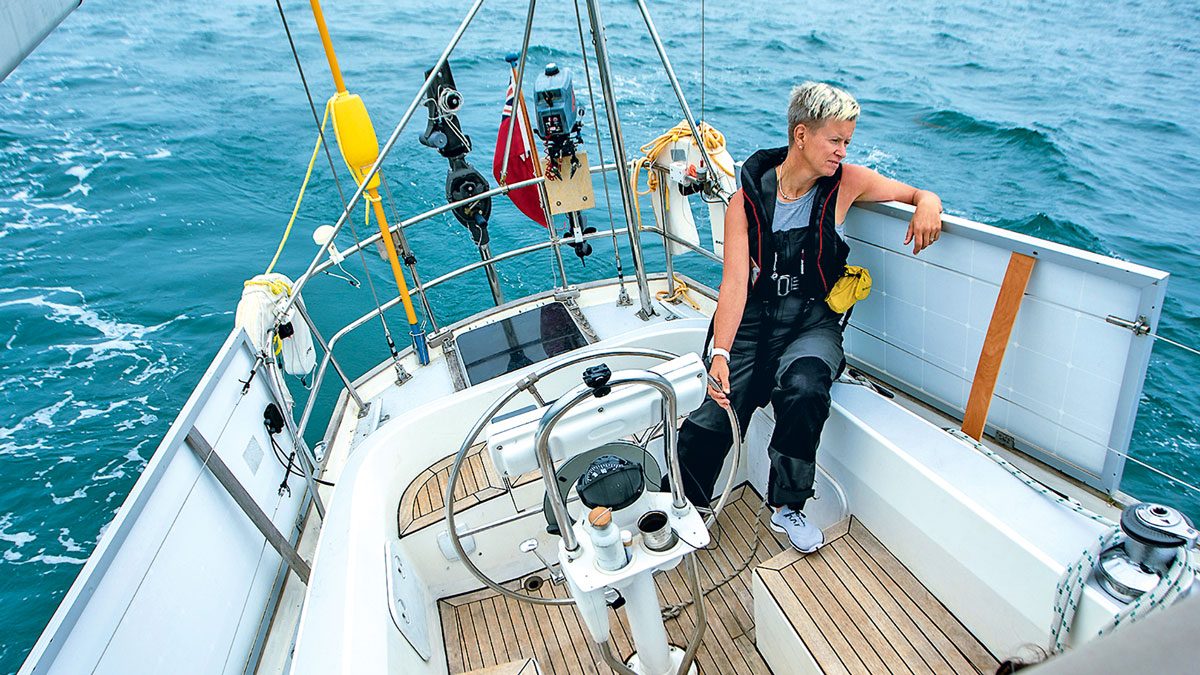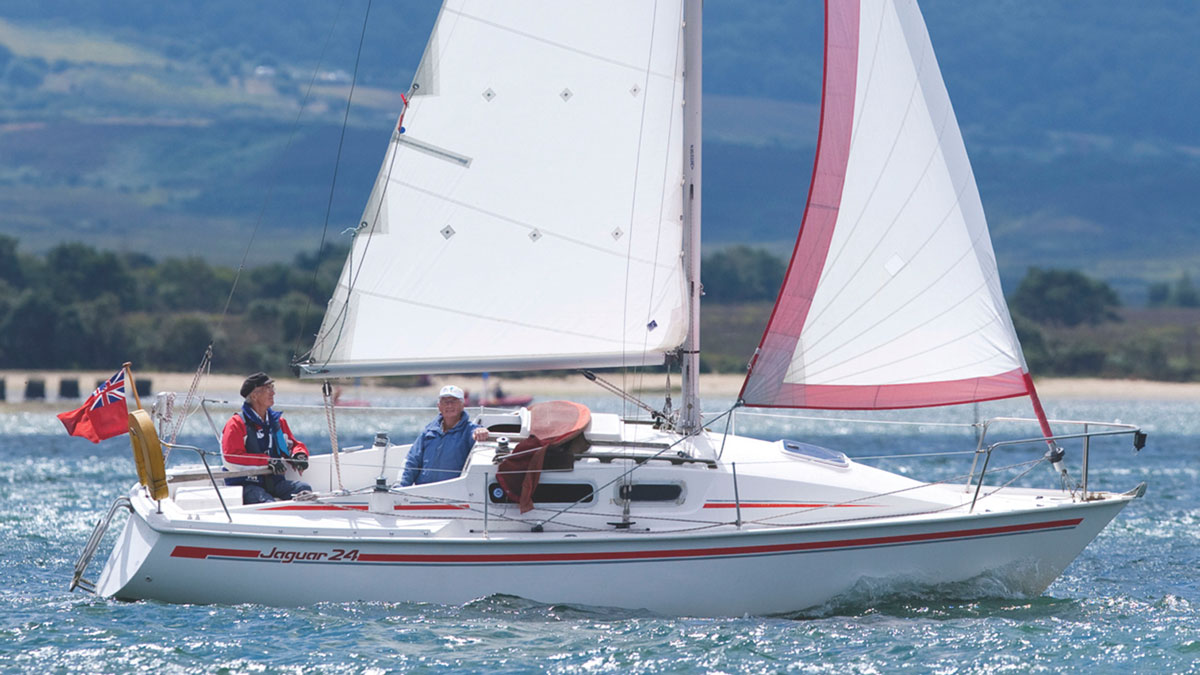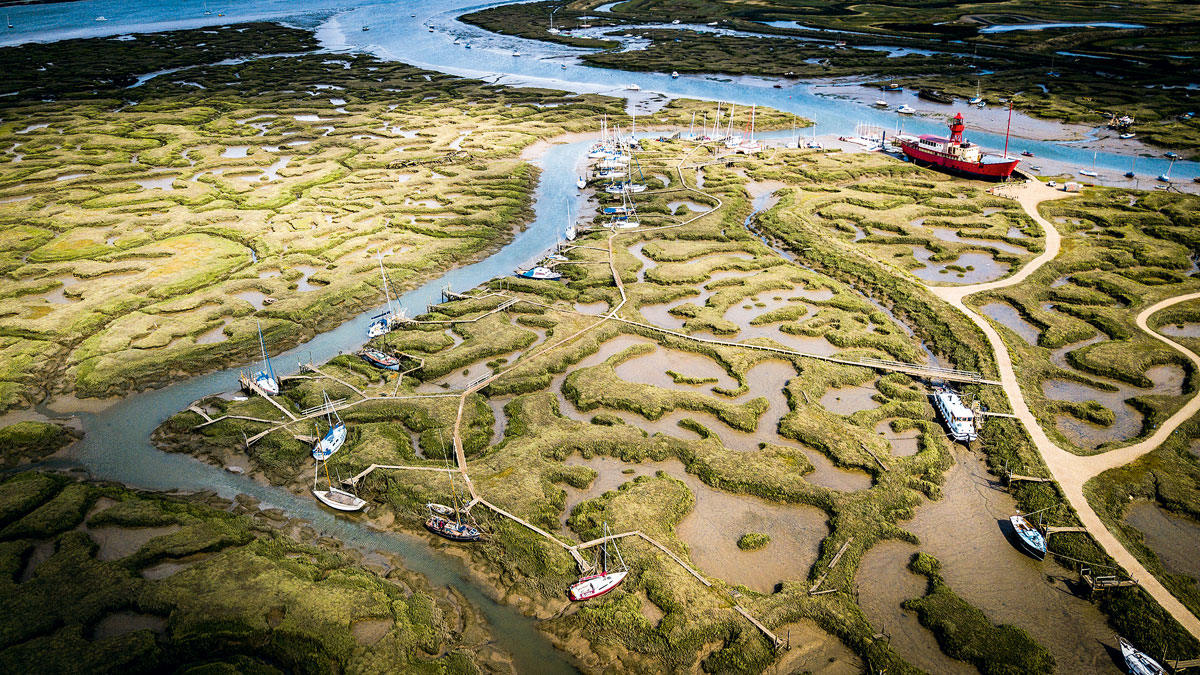Rigorous preparation, a back-up plan and keeping warm are among the key elements of a successful and pleasurable night sail, says David Pugh
The importance of pre-planning for night sailing was brought home to me recently, when we aborted a planned non-stop voyage from Poole to Dartmouth and made an unscheduled stop in Weymouth.
For Dorset sailors, Weymouth is a familiar port and a regular daysail destination. It’s also a very easy entrance, but as we approached, I realised the local knowledge I had didn’t help much at night.
The lights of the port mixed with those of the ferry moored just inside the breakwater, the busy seafront and the funfair to make them all but invisible.

Often, you sail shorthanded or solo at night, while other crew members rest, so plan accordingly. Credit: Richard Langdon
The green vertical lights on the northern breakwater had faded to a milky jade, while the two red lights, which my faulty memory told me marked the end of the southern breakwater, proved to be a cable or so inside the entrance.
Luckily, I was cautious enough to sail past the entrance at a safe distance before committing to it, by which time I had worked out what was where and matched it up with my daytime picture.
But it was sobering to think that my mistake with the red lights would have taken us straight into the breakwater had I followed it through.
By contrast, doing my homework would have told me that those two red lights to give a safe entrance to the harbour – a simple fact that would have been of enormous help, and which I used for a much more relaxed night-time visit only a week later.
Planning a night sailing
On the aforementioned voyage, I had planned to be at sea all night, arriving at Dartmouth in the early morning.
My error was to have not anticipated the possibility that we might change our plan – I hadn’t developed a “Plan B”.
Planning for a night sailing is much the same as for the daytime, but you have to be more organised. Chartwork is harder at night, and often you’re sailing shorthanded with someone asleep below. Anticipating changes can make for a less stressful passage.
People plan passages in different ways, but for me, the first step is always marking up the tidal atlas.
A ready reckoner of how the tide is expected to behave over the next few hours is essential to flexible passage making, especially if there are significant tidal gates such as races.

Tidal atlases are a useful ready reckoner when passage planning
Good tidal knowledge gives an immediate indication as to how practical a considered change of plan really is – or even if you’re too late on the tide to complete your original plan.
Combined with the weather forecast, it can also tell you a lot about sea state – a strong tide underneath you can be of great assistance in reaching your destination in a timely fashion, but if you’re also beating, you should be aware that wind-over-tide chop will be significant.
At night, waves seem to grow, and your ability to anticipate them is drastically reduced, so a knowledge of sea state is valuable.
Once you know the limitations set by the tide and/or weather, you can start considering ways in which you might shorten or abort the passage if necessary.
Ask any sailing instructor and she or he will tell you the importance of Plan B, whether you are crossing the Atlantic or simply preparing to come alongside. For night sailing, pay special attention to the pilot book to avoid tricky or poorly-lit entrances.
In daylight, the usual reasons for changing plans are inclement weather or some kind of equipment failure, but at night, the number one cause is usually crew.
The sea is a different and daunting place in the dark, with both wind and sea seeming stronger, so if some of your crew are night sailing for the first time, you should be aware that the chance of seasickness is increased, as is that of exhaustion.
Sleeping on board
Some people find sleeping on a pitching, tossing boat for four hours at a time a doddle, but many others find sleep impossible.
With a lack of sleep comes severe fatigue, and with severe fatigue come mistakes and nausea. Good skippers will know their crew
limitations and avoid pushing them too far, but if your crew are becoming exhausted, you should at least be prepared to head for port if possible.
That said, sleeping on board is a skill you can learn, so if you have regular crew and would like to start making longer night passages, start out with a few voyages lasting part of the night, preferably in calm conditions when below decks is a comfortable place to be.
After a while, with a more confident crew who are used to getting their head down as soon as they go off watch, you can sail from dusk until dawn or even undertake consecutive night sails with aplomb.
Safety while night sailing
The key to safety at night is to see and be seen. Make sure that you show the correct navigation lights at all times, that your radar reflector
is hoisted, and that your crew know where the anti-collision flares are kept.
It’s also useful to keep a torch at hand to shine on the sail to increase your visibility.

Do your homework and learn light characteristics – identifying a buoy or lighthouse is very reassuring
Any night sailing crew should also know how to recognise and interpret the commonly-seen lights of ships, while at least the skipper should know what to do if a tangle of lights on the horizon is identified to be a vessel over 50m with a 200m tow, and how to recognise quirky light characteristics such as that of a south cardinal buoy.
Another very useful modern tool for avoiding collision is AIS. It’s easy to understand, and most sets have an alarm that will sound if a target passes you within a set safety zone – a handy prompt for a below-decks skipper!
AIS will also tell you a vessel’s MMSI number, giving you a direct means to call them if necessary.
Lights and AIS notwithstanding, the onus is on you to avoid collision.

Choose your destination carefully – rocky anchorages like this are best left until daylight
This is never more apparent than when sailing through an area of pot buoys, when nothing will substitute for a good pair of eyes on watch. But even the best eyes can miss black buoys in black water, so avoid these areas if possible.
The final, crucial safety point to stress is to make every effort to keep your crew on board.
Lifejackets should be worn at all times, and any crew outside the cockpit should always clip on – we tend to clip on in the cockpit too, especially if there’s only one person on deck.
Your chances of recovering an MOB at night are very slim.
Why sail at night?
For many, especially those tied to the all-too-meagre holiday entitlement permitted by most employers, night sailing is a way to change your cruising ground.
A common idea is to make a passage lasting one or two nights to get to a distant destination, before pottering slowly back, exploring the intervening ports. In other words, night sailing is a way to cover miles.
It’s pretty simple, really. I can realistically plan for an average speed of 4.5 knots in my Contessa 26 Red Dragon.
That means that a 100-mile passage will take me around 24 hours, so to sail the 130 miles from Poole to Falmouth non-stop, I would need to spend a night at sea.
However, if I were only to sail in daylight, it would take three days sailing of 10 hours each, even without allowing for any diversions from the direct route to get to the intervening ports – that’s a lot of time saved.
The joy of night sailing
There’s one more reason for night sailing, and for me it’s one of the most important – it’s immensely rewarding.
In daylight, there are so many prompts to give you wind direction and sail set that there is really no excuse for not sailing the boat to her full potential.
At night, gone are the telltales, Windex, ripples on the water, flags on the shore – there’s just you, the helm and the feel of the wind on your cheek.
It’s excellent sailing practice, and even if you have an electronic wind indicator, I think it’s worth turning it off from time to time to practise your wind awareness.
These days, sail power is exclusively used for enjoyment, and for me there are few things more enjoyable than watching the sun set over a benign sea, spending the night listening to the sea and feeling at one with the boat, passing a watch below lulled by the sound of water chasing down the hull and waking to steer through the grey twilight to the magical sparkle of a new dawn.
It’s escapism in its purest form, and thoroughly recommended.
10 tips for night sailing
- Keep a good lookout for other vessels or obstacles, lit or unlit.
- Wear a lifejacket and clip on, especially if you’re on watch on your own. The odds of being found at night are slim.
- Wrap up warm. Even in summer, nights at sea are chilly. Take plenty of layers and put them on early.
- Swot up on your lights – they’re invaluable in deciphering the night muddle.
- Be seen! Use correct nav lights, deploy a radar reflector and have a torch ready to shine on the sails.
- If you suffer from seasickness, dose up on the tablets early to fight it off.
- Don’t overstimate your abilities. If your crew aren’t confident steering in darkness, you might manage a single watch through a short summer night, but spring, autumn and winter passages need two or more watches.
- Always have a Plan B, even if it is retracing your steps. Know what is possible with the given conditions and tide.
- Take time to enter strange ports. If you can’t work out the entrance, can you anchor safely until daylight, or stay offshore away from danger?
- Provision well. It is amazing how hungry you get in the small hours. Keep hot drinks on the go too – a Thermos helps here.
How to sleep sailing shorthanded
John Apps stresses the importance of sleeping sufficiently on long-distance single-handed passages, and explains how to snatch safe naps without…
Sailing solo: how to go from crewed to single-handed
Round the world sailor Ian Herbert-Jones shares valuable advice on how to transition from crewed to single-handed sailing
Seamanship tips from a seasoned sailing instructor
Sticky Stapylton has sailed thousands of miles and taught numerous people how to sail. He shares some of his seamanship…
Understanding tidal streams and heights
Understanding tidal streams and heights is essential for passage planning and safe navigation. The RYA's former chief examiner, James Stevens,…
Want to read more articles like this?

A subscription to Practical Boat Owner magazine costs around 40% less than the cover price.
Print and digital editions are available through Magazines Direct – where you can also find the latest deals.
PBO is packed with information to help you get the most from boat ownership – whether sail or power.
-
-
-
- Take your DIY skills to the next level with trusted advice on boat maintenance and repairs
- Impartial, in-depth gear reviews
- Practical cruising tips for making the most of your time afloat
-
-
Follow us on Facebook, Instagram, TikTok and Twitter








